Study Skills
Taking the Leitner System to the Next Level! A Strategy for Independent Learners (Includes Free Download!)
Having examined how to use CardEd to introduce the Leitner System to young learners, I want to consider how to use it effectively with independent learners.
You may recall in my first post on the topic, I advised having one piece of information per card. This is known as the minimum information principle. Adhering to this principle reduces the risk of students mistaking recognition for recall and tricking themselves into thinking information is known/understood simply on the basis that they are familiar with it.
Flashcards might have:
- A word on the front and the definition on the back;
- A question on the front and the answer on the back;
- The name of a mathematical formula on the front and the complete formula on the back;
- An acronym on the front and its meaning on the back;
- A date on the front and a significant historical event on the back.
- A country on the front and its capital on the back.
Previously, I considered the Leitner System from the point-of-view of a teacher implementing it at school, i.e. operating on a 5-day week. In today’s post, I include schedules over a longer time-span (28 days and 64 days). This is because the Leitner System is based on the theory of spaced repetition.
Gradually increasing the time since a topic was last reviewed creates a desirable difficulty by making it harder to recall the information. This retrieval difficulty serves to increase the storage strength of the information and actually makes it easier to recall it next time it is reviewed. The optimal time to review information is when you are just on the point of forgetting it. The Leitner System uses this phenomenon to support long-term retention as the review periods gradually increase.
As indicated, I include 2 calendars and tracking documents (28 day and 64 day schedules) with this post. To implement the 28 day schedule, learners will need 5 boxes / 5 labelled folders / a box divided into 5 sections. Those using a 64 day schedule will have 7 boxes / 7 labelled folders / 7 sections in their Leitner Box.
Rather than using separate boxes/folders, I created a Leitner Box using an old wooden box. I added tabs to some postcards and used these as dividers. Creating a Leitner Box of their own could be a good ‘up-cycling’ project for learners. Whatever is used, the Leitner System simply needs to be functional for each individual learner. It can be helpful to use an elastic band around cards in each of the sections to keep them organised or to prevent chaos if the box is dropped!
As demonstrated in the 2 videos I posted previously, pupils begin by placing all their flashcards in section 1 of their box. Each day the cards in section 1 are reviewed and known ones move to section 2. Section 2 cards are reviewed every 2nd day with known ones moving to section 3. If an error is made, regardless of where it occurs, the card is moved back to section 1. This diagram demonstrates this principle (albeit with fewer boxes) and the attached calendars outline the review schedule (for 28/64 days).
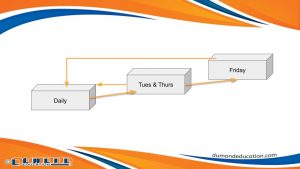
In the videos accompanying the earlier posts, because the aim was merely to show how the system can be introduced to young learners, I solely concentrated on a set amount of content. With older pupils, the hope is the Leitner System becomes a core part of their study plan. To this end, it is important new flashcards are added to box 1 regularly. Students might start with adding 5-a-day, gradually building up to adding more and more cards. Some learners find it useful to purchase coloured flash-cards and colour-code according to subject; this is personal preference.
At the outset, it is useful to allocate some class time to the creation of flashcards. This may be particularly helpful if pupils are struggling to identify key information and apply the minimum information principle.
Because the Leitner System is such an effective study method, lots of apps have been created based on the concept of using flashcards for spaced practice. The original of these, Supermemo, was created by Piotr Wozniak. He created an algorithm now used by many of the other apps. As well as Supermemo, here are some other flashcard/spaced retrieval study apps. Some are free while others may charge a fee or offer upgrades at an additional cost.
Anki, Brainscape, Cram, StudyBlue, StudyStack, and Quizlet.
There are also specific language-learning tools, e.g., Duolingo.
Included below are images of the 28-day and 64-day Leitner System trackers. Hopefully, these will be of use to you or to learners in your class/home. Pupils should check off their study each day on the numbered calendar document. They can then use the corresponding calendar with box numbers to check their task for the day. I recommend storing them in the box / sticking them to it.
I have added these documents as a free download at the bottom of this post.
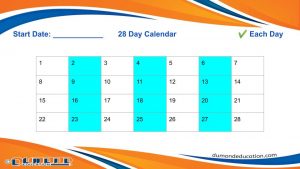
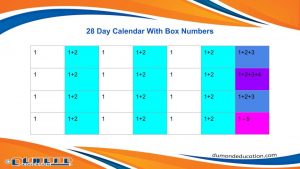

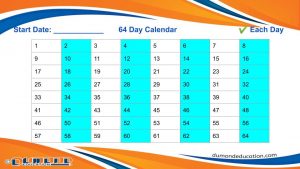

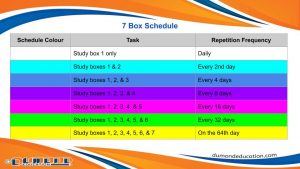
Free Download!
The Leitner System Calendar & Tracking Documents
